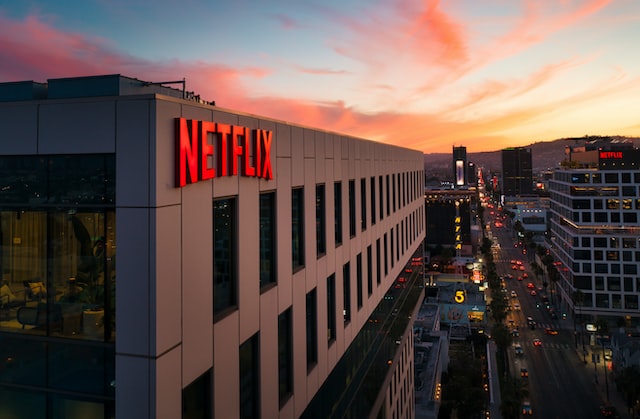Before we dive deep into the Marketing Mix (4Ps), let’s get the business overview of Netflix. Netflix is a popular American media services provider and production company founded in 1997. It offers a subscription-based streaming service that allows users to watch a wide range of TV shows, movies, documentaries, and more on internet-connected devices.
Netflix has expanded its services globally and is now available in over 190 countries. In addition to offering content from various studios and networks, Netflix also produces its original programming, which has gained critical acclaim and popular success.
Some of Netflix’s most popular original shows include Stranger Things, The Crown, Narcos, Orange is the New Black, and House of Cards. Netflix has also produced successful original movies like Roma, Bird Box, and Marriage Story.
Netflix has generated over $33.7 billion in revenue and $5.4 billion in net income in 2023.
Netflix: Thriving on a Maverick Culture
Here is the Marketing Mix (4Ps) for Netflix
A marketing mix, also known as the 4Ps of marketing, is framework marketers use to develop and implement effective marketing strategies. The concept helps businesses identify and optimize the key components necessary to promote and sell their products or services. The 4Ps of the marketing mix are Product, Price, Place, and Promotion.
In addition to the traditional 4 Ps, marketers have expanded their strategies by incorporating additional elements (People, Process & Performance) to help them better understand and reach their target audiences. But we will focus on the 4Ps as they are the foundation of any marketing strategy. In this article, we will understand the marketing mix (4Ps) of Netflix.
What is a Marketing Mix? What are the 4Ps of Marketing?
Product
- Content: Netflix’s primary product offering is its extensive library of movies, TV shows, documentaries, and original content. The platform offers a wide range of genres to cater to diverse tastes, including action, comedy, drama, horror, romance, and more. Netflix also invests heavily in producing its original series and movies, which have become increasingly popular and help differentiate it from competitors.
- Streaming Quality: Netflix provides a high-quality streaming experience, with options for HD and Ultra HD streaming (for those with compatible devices and internet connections). The company continuously works to improve streaming quality and minimize buffering issues, ensuring a smooth viewing experience for customers.
- User Experience: The Netflix platform is designed to be user-friendly, with an intuitive interface and personalized content recommendations based on the user’s viewing history and preferences. The service also allows users to create multiple profiles within a single account, catering to different family members’ tastes and preferences.
- Accessibility: Netflix is available across multiple devices, such as smartphones, tablets, computers, smart TVs, and gaming consoles, allowing customers to access content whenever and wherever they want.
- Language and Subtitle Options: Netflix offers content in multiple languages, with options for subtitles and dubbing, making it accessible to a global audience. The company also localizes content for specific regions, providing more relevant and relatable content for different cultural groups.
- Download Feature: Netflix allows users to download select content for offline viewing, providing additional convenience and flexibility for users on the go or with limited internet access.
Price
- Subscription-based model: Netflix operates on a subscription-based model, where customers pay a fixed monthly fee to access its entire content library. This model provides customers with the convenience of unlimited streaming without the need for individual content purchases or rentals.
- Tiered pricing plans: Netflix offers multiple pricing plans that cater to different customer needs and budgets. The basic plan provides standard definition streaming and access on one screen, while higher-tier plans offer HD or Ultra HD streaming and simultaneous streaming on multiple screens. By offering tiered pricing, Netflix caters to a broader audience and allows customers to choose a plan that best suits their preferences and budget.
- Free trial: Netflix has historically offered new customers a free trial period, allowing them to experience the platform and content before committing to a paid subscription. This strategy helps attract potential customers and demonstrates confidence in the value of their product.
- No advertisements: Netflix’s subscription model allows the platform to be free of advertisements, providing an uninterrupted viewing experience. This is a significant selling point for customers, differentiating Netflix from other platforms that rely on ad-supported revenue models.
- Competitive pricing: Netflix continually evaluates its pricing strategy to remain competitive within the streaming market. The company must balance customer affordability with generating revenue for content acquisition and production. While pricing may vary by region, Netflix generally aims to provide good value compared to its competitors.
- Pricing flexibility: Netflix can adjust its pricing structure based on market conditions, customer feedback, or changes in its content offerings. This allows the company to adapt its pricing strategy to maintain a competitive edge and meet its business objectives.
Place
- Online platform: Netflix is an online streaming platform, meaning its content is available exclusively via the Internet. This digital distribution model allows Netflix to reach a global audience, reducing the limitations associated with physical distribution channels such as DVDs or Blu-rays.
- Device compatibility: Netflix focuses on making its service available across multiple devices, including smartphones, tablets, computers, smart TVs, and gaming consoles. This ensures that customers can access Netflix content on their preferred devices whenever and wherever they choose.
- Global expansion: Netflix has aggressively pursued international expansion, making its service available in over 190 countries. This has allowed the company to tap into diverse markets and reach a wide range of customers. As part of its global expansion, Netflix invests in localized content and adapts its platform to cater to regional tastes and preferences.
- Content delivery network (CDN): To ensure a smooth streaming experience for customers worldwide, Netflix has built its own global content delivery network (CDN) called Open Connect. This network of servers helps reduce buffering and latency issues by caching content closer to the end users, resulting in a better viewing experience.
- Partnerships: Netflix has partnered with various internet service providers (ISPs), telecom companies, and device manufacturers to improve its accessibility and reach. These partnerships can involve bundling Netflix subscriptions with internet plans, pre-installing the Netflix app on devices, or even offering exclusive deals for customers of specific providers.
- User-friendly interface: Netflix’s platform is designed to be easy to navigate and use, with personalized content recommendations, multiple profiles, and search capabilities that help users find and discover content efficiently. This focus on user experience ensures that customers can easily access and enjoy the content they want.
Promotion
- Advertising: Netflix invests in both online and offline advertising campaigns to reach a wide audience. The company uses digital marketing channels such as social media, search engine advertising, display ads, and traditional channels like billboards, TV commercials, and print ads to promote its services and original content.
- Public Relations: Netflix employs public relations strategies to create a positive brand image and generate buzz around its platform and content. This includes press releases, media interviews, participation in industry events, and leveraging relationships with industry influencers and celebrities associated with Netflix’s original productions.
- Content marketing: Netflix uses content marketing strategies to engage potential and existing customers by sharing behind-the-scenes content, trailers, interviews, and other exclusive material across its social media platforms, YouTube channel, and blog. This helps to build anticipation and excitement around new releases and keeps subscribers engaged.
- Original content promotion: Netflix heavily promotes its original series and movies, as they are a key differentiator from competitors. The company invests in marketing campaigns specifically tailored to individual productions, including targeted advertising, social media engagement, and even experiential marketing events like pop-up experiences or immersive installations.
- Social media: Netflix has a strong presence on social media platforms such as Facebook, Instagram, Twitter, and YouTube. The company uses these platforms to share content, interact with users, and create conversations around its brand and offerings. Social media also serves as a channel for customer support and feedback.
- Partnerships and collaborations: Netflix partners with other brands and companies for co-marketing initiatives and cross-promotions. These partnerships can involve product placements, exclusive content deals, or joint marketing campaigns that help raise brand awareness and attract new customers.
- Free trials and promotions: As mentioned earlier, Netflix has historically offered free trials to new customers, giving them a chance to experience the platform before committing to a subscription. The company may also run occasional promotional offers, such as discounted subscription rates, to attract or retain new customers.











